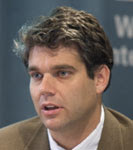-
Could Threat of Regional Cholera Pandemic Finally Topple Zimbabwe’s Mugabe?
›December 23, 2008 // By Rachel Weisshaar
Zimbabwe’s current cholera epidemic has killed more than 1,100 people and sickened nearly 24,000, prompting the United States, the United Kingdom, and some African nations to press for sanctions on—and the resignation of—President Robert Mugabe. The impoverished country ranks 151 out of 177 on the UN Human Development Index and has an average life expectancy of 34 for women and 37 for men. Although it has suffered yearly cholera outbreaks since 1998, this year’s epidemic dwarfs previous ones. The epidemic is being aggravated by severe food shortages and the country’s high prevalence of HIV/AIDS, and is expected to continue through the end of the rainy season in March.
-
Greening the U.S. Army: Report Calls Environment Critical to Post-Conflict Operations
›December 11, 2008 // By Rachel WeisshaarGreen Warriors: Army Environmental Considerations for Contingency Operations from Planning Through Post-Conflict (summary) is a comprehensive new RAND report on the U.S. Army’s environmental record in combat and peacekeeping operations. Green Warriors, which was commissioned by the Army Environmental Policy Institute, gives four main reasons why the Army should care about its environmental impacts, particularly in light of its lengthening overseas engagements:
- The environment can threaten soldiers’ health (through disease, polluted air or water, or exposure to hazardous substances);
- The military can harm its credibility with local populations by improperly disposing of waste or by damaging farmland or water supplies;
- Reconstruction projects that improve environmental conditions can foster support for the United States and the host-country government it supports, improving economic growth and security; and
- Environmental problems are often transboundary, and it is important to avoid allowing deficient U.S. environmental practices strain our relationships with other countries, especially given their importance to U.S. military activities.
Green Warriors emphasizes that environmental considerations are particularly significant during the post-conflict phase of operations:
[L]ocals often care deeply about the environment, which can be critical to their survival, livelihood, and well-being. Vital environmental issues can include access to clean drinking water, effective sewage systems, and viable farmland (see Box 1.1). Restoring or building these basic infrastructures is often essential for the economic and social development necessary for stability. To the extent that such projects improve cooperation with locals, they can lower security risks, improve intelligence, and speed reconstruction.
According to Green Warriors, the Army possesses extensive environmental policies and regulations for domestic and permanent foreign installations. Yet there are extremely few environmental regulations for contingency operations. The authors make the following recommendations:
- Improve environmental policy and guidance. The Army Strategy for the Environment, the Army’s new field manual on stability and reconstruction operations (New Security Beat coverage), and DoD’s 2005 decision to elevate post-conflict operations to the same level as combat operations (DoD Directive 3000.05) all provide a foundation upon which to build a standard DoD-wide environmental policy.
- Promote an environmental ethic and culture that extends to contingency operations. The Army must encourage soldiers and commanders to recognize and embrace the strategic benefits of good environmental stewardship.
- Incorporate environmental issues more extensively into planning. Commanders should receive high-quality environmental information and analysis, and risk assessments should be routinely undertaken.
- Improve environmental training and awareness. Commanders, soldiers, and non-combatant personnel should receive training on environmental issues both prior to and during their deployment. This training should include lessons learned from field experience.
- Expand environment-related investment. The Army should invest in personnel with the skills to implement a global environmental program and expand research and development to create technologies that would minimize environmental impacts of Army’s operations.
- Use the concept of sustainability as a guiding principle. The Army Strategy for the Environment calls sustainability the “keystone” of the Army’s environmental strategy, and the RAND report encourages the Army to expand this principle into all aspects of its contingency operations.
In a memo released with the report, Addison Davis IV, deputy assistant secretary of the Army for environment, safety, and occupational health, says that “the Army has the power to implement most” of the report’s recommendations. The question remains: Is the Army’s leadership willing to do so?
Photo: U.S. Army Spc. Gabriela Campuzano, a water purification specialist with the 94th Brigade Support Battalion, 4th Brigade Combat Team, 10th Mountain Division, inspects one of three water storage tanks at a water purification project site at the Baghdad Al Jadeeda Police Station in Baghdad, Iraq, June 12, 2008. The water site provides the local community with clean drinking water. Courtesy of Staff Sgt. Brian D. Lehnhardt, the U.S. Army, and Flickr. -
Sustaining the Environment After Crisis and Conflict
›December 4, 2008 // By Rachel Weisshaar “Unfortunately, disasters are a growth industry,” said Anita Van Breda of the World Wildlife Fund (WWF) at “Sustaining Natural Resources and Environmental Integrity During Response to Crisis and Conflict,” a November 12 meeting sponsored by the Wilson Center’s Environmental Change and Security Program. But the impact of increased disasters on the environment is not a priority for first responders: According to Charles Kelly, an affiliate of the Benfield Hazard Research Centre at University College London, their perspective is, “How many lives is it going to save, and how much time is it going to take?” Environmentalists, who tend to think in terms of decades and generations, can find it difficult to communicate effectively with aid workers. “You give a 30-page report and it’s not going to be read, and there’s going to be no action,” said Kelly.
“Unfortunately, disasters are a growth industry,” said Anita Van Breda of the World Wildlife Fund (WWF) at “Sustaining Natural Resources and Environmental Integrity During Response to Crisis and Conflict,” a November 12 meeting sponsored by the Wilson Center’s Environmental Change and Security Program. But the impact of increased disasters on the environment is not a priority for first responders: According to Charles Kelly, an affiliate of the Benfield Hazard Research Centre at University College London, their perspective is, “How many lives is it going to save, and how much time is it going to take?” Environmentalists, who tend to think in terms of decades and generations, can find it difficult to communicate effectively with aid workers. “You give a 30-page report and it’s not going to be read, and there’s going to be no action,” said Kelly. -
How to Win (Green) Friends and Influence People (Who Are Interested the Environment)—Without Leaving Your Computer
›November 28, 2008 // By Rachel WeisshaarNew York Times environment reporter Andrew Revkin recently invited readers to post cost-effective environmental proposals on his blog, Dot Earth. He promised to send the 10 best ones, as determined by readers’ recommendations, to the Obama transition team on energy and the environment.
Intriguingly, two of the proposals focus on population. “In a world of increasing scarcity, if we do not get a handle on our own population, it will get a handle on us,” writes one reader. “Because of sustained exponential population growth, we are collectively destroying what remains of the natural world. We are also putting our species at grave risk for rapid catastrophic population decline. We cannot expect to sustain exponential population growth indefinitely,” warns another.
If you missed this opportunity to put in your $0.02 on environmental and population issues, don’t worry: You can submit your comments directly to the energy and environment policy team on the Obama transition website.
Yet another venue for influencing influential people is Thomas Friedman’s Chapter 18 Project. Friedman’s latest book, Hot, Flat, and Crowded: Why We Need a Green Revolution—And How It Can Renew America, consists of 17 chapters, but he has said that the second edition will include an additional chapter comprising readers’ best ideas on how to make the transition to clean energy, improve our global environmental stewardship, and revitalize America’s economy and international reputation by “going green.” You can submit your proposals on his website. -
“I’d Like to Thank the Academy…”: ‘New Security Beat’ Wins Global Media Award
›November 26, 2008 // By Rachel Weisshaar Upon arriving in Los Angeles last week to accept a Global Media Award for Excellence in Population Reporting from the Population Institute (PI) —the New Security Beat won the “Best Online Commentary” award—I was greeted by a massive gift basket from PI. The rest of the week was equally bountiful, full of interesting people and vibrant exchanges of ideas.
Upon arriving in Los Angeles last week to accept a Global Media Award for Excellence in Population Reporting from the Population Institute (PI) —the New Security Beat won the “Best Online Commentary” award—I was greeted by a massive gift basket from PI. The rest of the week was equally bountiful, full of interesting people and vibrant exchanges of ideas.
After a dinner for the award-winners and PI and Population Media Center (PMC) board members and staff on Monday night, we spent most of Tuesday at a conference sponsored by PMC designed to help Hollywood writers and producers incorporate climate change and other serious environmental issues into their work. After Dr. Howard Frumkin of the Centers for Disease Control and Vice Admiral Dennis McGinn (Ret.) outlined the health and security impacts of climate change, various industry insiders—from “CSI” and Fox, for instance—shared how they have managed to include climate change impacts in their jokes, dialogue, and storylines without sacrificing entertainment value. It was truly fascinating, and I encourage you to read more about it in another New Security Beat post.
Paul Ehrlich, who is Bing Professor of Population Studies at Stanford University, was the keynote speaker at the awards ceremony on Tuesday night, and he discussed the connections between population and environment in his trademark candid manner. “As long as you keep the population and consumption growing, you are, in the technical term, screwed,” he said. Bill Ryerson, president of both PI and PMC, and former CNN anchor Carol Lin presented the awards:- Best Combined Media Effort: DZMM Radio, Philippines
- Best News Service: Reuters
- Best Online News Service: PUSH Journal (Communications Consortium Media Center)
- Best Individual Reporting Effort: More: Population, Nature, and What Women Want (Robert Engelman)
- Best Film or Miniseries: “Planet in Peril” (CNN)
- Best Print Editorial: “Global Overpopulation Is the Real Issue” (Boris Johnson, Mayor of London)
- Best Online Commentary: New Security Beat blog (Environmental Change and Security Program, Wilson Center)
- Best Magazine Article: “Why Have Scientists Succumbed to Political Correctness?” (Albert Bartlett)
- Best Radio Show: “The Naked Scientists” (BBC Radio)
- Best TV Show: “Morning Joe” (Joe Scarborough)
- Best Editorial Cartoonist: Don Wright (Winner of the Pulitzer Prize for Editorial Cartooning, 1966 and 1980)
Population remains an underreported issue, but as challenges like climate change, food shortages, water scarcity, and lack of youth opportunity in the Middle East rise to the top of the international agenda, a growing number of journalists seem to be incorporating demographic angles into their stories. Thanks go to PI for calling attention to some of these important contributions.
Photo: The New Security Beat‘s Global Media Award for “Best Online Commentary.” Courtesy of Dave Hawxhurst and the Wilson Center. -
Climate Change in Mainstream TV and Film: Don’t Be Preachy, Preach Entertainment-Industry Insiders
›November 20, 2008 // By Rachel WeisshaarAs U.S. governors and international climate representatives met at the Beverly Hills Hilton for California Governor Arnold Schwarzenegger’s climate change summit on November 18, a group of Hollywood writers and producers—plus a few climate change experts—gathered on the other side of Los Angeles at the Skirball Cultural Center for “Changing Climate…Changing People: Connecting to the Biggest Story of Our Time,” a unique conference sponsored by the Population Media Center on how to incorporate climate change into mainstream TV and film.
Entertainment industry insiders like Sonny Fox emphasized that “earnest isn’t enough and won’t cut it”—that a show or film’s entertainment value cannot be compromised by its addressing serious issues like climate change impacts. Yet Chris Alexander, senior vice president of corporate communications for 20th Century Fox, showed that this is possible, with examples of how “The Simpsons,” “King of the Hill,” and “Boston Legal” have seamlessly incorporated environmental issues into jokes, dialogue, and storylines.
David Rambo, a writer and supervising producer for “CSI,” described how “CSI” has addressed climate change impacts in two separate shows: one that examined the surprisingly large effect of a degree or two difference in temperature; and another that explored the high concentration of pharmaceuticals in water that has been recycled due to water shortages. According to Rambo, after that episode aired, “CSI” received grateful letters from public officials and educators from around the country, who said that the fact that “CSI” had addressed water reuse had made it acceptable for them to broach this once-taboo topic.
The conference was also anchored by some heavy-hitters—Dr. Howard Frumkin, director of the National Center for Environmental Health/Agency for Toxic Substances and Disease Registry at the U.S. Centers for Disease Control and Prevention; and Vice Admiral Dennis McGinn (Ret.). Frumkin discussed the potential health impacts of climate change, which include increased levels of air pollution; higher incidence of allergies; geographic spread of vector-borne and waterborne diseases; severe disruptions to water and food supplies; and mental health problems, often resulting from exposure to natural disasters. McGinn explained that because climate change is a threat multiplier for instability, it could increase the risk of humanitarian disasters, failed states, civil conflict, extremism, competition over scarce natural resources, and mass migration.
In addition to panels, the conference also featured a one-act play, “Shuddering to Think,” about the challenges of incorporating serious issues into mainstream entertainment. It sounds dull—but was actually funny and incisive, thanks to sharp writing by Jon Robin Baird and adept acting by Bruce Davison, Scott Wolf, and Bradley Whitford, whom you may remember as Josh Lyman from The West Wing. Speaking after the performance about media’s power to convince the public to get serious about climate change, Whitford observed, “The press failed, the government failed, science failed—but Al Gore’s movie [An Inconvenient Truth] worked.” -
Fertile Fringes: Population Growth Near Protected Areas
›November 7, 2008 // By Rachel Weisshaar “Protected areas are the backbone of biodiversity conservation strategies,” so it is critical to examine how population growth is affecting them, said Justin Brashares of the University of California, Berkeley, at “Fertile Fringes: Population Growth at Protected-Area Edges,” an October 22, 2008, meeting sponsored by the Environmental Change and Security Program (ECSP). “Biodiversity conservation objectives are being impacted by higher deforestation rates, [natural resource] offtake rates, [and] increasing pressure on the protected area” due to high local population growth, explained George Wittemyer of Colorado State University. Brashares and Wittemyer, who recently co-authored an article on population and protected areas in Science, were joined by Jason Bremner of the Population Reference Bureau.
“Protected areas are the backbone of biodiversity conservation strategies,” so it is critical to examine how population growth is affecting them, said Justin Brashares of the University of California, Berkeley, at “Fertile Fringes: Population Growth at Protected-Area Edges,” an October 22, 2008, meeting sponsored by the Environmental Change and Security Program (ECSP). “Biodiversity conservation objectives are being impacted by higher deforestation rates, [natural resource] offtake rates, [and] increasing pressure on the protected area” due to high local population growth, explained George Wittemyer of Colorado State University. Brashares and Wittemyer, who recently co-authored an article on population and protected areas in Science, were joined by Jason Bremner of the Population Reference Bureau.
To Stay or To Go?
“Many of the protected areas that we have today in sub-Saharan Africa and in Latin America are carryovers of areas set aside by colonial governments,” said Brashares, “and for many researchers and for many communities, the creation of parks is seen to come at the cost of local communities.” Yet certain features can encourage people to move near protected areas, including:- Services made available by foreign assistance, such as health care, education, and livelihoods programs;
- Employment opportunities as park staff or in the tourism industry;
- Better ecosystem services, including food, water, wood, and traditional medicine;
- Easier access to markets, due to roads built to attract tourism; and
- Improved security provided by park guards and government staff.
Other features of protected areas deter migrants, including:
- Land-use restrictions;
- Conflict with wildlife (e.g., attacks on livestock and crops);
- Disadvantages associated with tourism, including higher cost of living and potential loss of cultural heritage;
- Isolation from urban centers; and
- Conflict with park staff, government representatives, or rural militias.
Higher Population Growth Near Protected Areas
Brashares and Wittemyer examined IUCN Category I and II protected areas in Africa and Latin America—which limit human activity within their boundaries—and excluded potentially confounding urban, marine, and new parks. Using UN Environment Programme population data from 1960-2000, they compared population growth in a 10-kilometer “buffer zone” surrounding each protected area with average rural population growth for that country. In 245 of the 306 parks they examined—and 38 of the 45 countries—population growth at protected-area edges was significantly higher than average national rural population growth.
Brashares and Wittemyer found three factors correlated with higher levels of population growth: more money for parks (as measured by protected-area funds from the Global Environment Facility); more park employees; and more deforestation on the edges of protected areas. Brashares emphasized, however, that there could be equally relevant correlations between population growth and employment in extractive industries, but that “the timber industry won’t give us their data and the mining industry and the oil industries aren’t so happy to share.” Thus, the study might inadvertently penalize NGOs and international organizations for their transparency.
Some researchers hypothesized that because protected areas are usually located in ecologically dynamic areas, this ecological wealth might be attracting new residents, rather than the protected areas themselves. But Brashares and Wittemyer found that proximity to a protected area, not general ecological abundance, was driving the trend. Others suspected that population grows at protected-area edges because the people who have been displaced by the creation of a park move to the park’s border. But population growth rates within the parks have been mostly stable or positive, so Brashares and Wittemyer doubt this is driving the trend.
Implications for Conservation
Brashares and Wittemyer outlined several policy implications of their research:- Emerging infectious diseases are a serious risk in areas with high human density close to wildlife populations, so governments and international organizations should try to limit potential outbreaks near protected areas.
- If the effectiveness of a protected area is measured by its ability to preserve biodiversity for generations, then community development programs must be executed carefully. For instance, roads and schools should not be built in an ecologically fragile corridor between two parks.
- Multi-use buffer zones that make core areas less accessible can allow individuals to continue to benefit from their proximity to nature while protecting biodiversity. “Some of the best protection of biodiversity is through isolation,” said Brashares.
Bremner took issue with some of Brashares’ and Wittemyer’s methods and conclusions; his full critique is available on the New Security Beat. Although Bremner agreed that migration—not natural increase—is likely driving higher population growth around protected areas, he believed the authors did not provide adequate evidence to demonstrate that this migration is driven by investments in conservation. “I hope that publishing this conclusion here in Science doesn’t provide our detractors, those who don’t want us to be spending on conservation, with the means to limit future spending for international conservation,” said Bremner.
Photo: Justin Brashares. Courtesy of Dave Hawxhurst and the Woodrow Wilson Center.
For more information, including a webcast of this event, visit ECSP’s website. To receive invitations to future events, e-mail ecsp@wilsoncenter.org. -
United Nations Observes International Day for Preventing the Exploitation of the Environment in War and Armed Conflict
›November 6, 2008 // By Rachel Weisshaar Each November 6, the International Day for Preventing the Exploitation of the Environment in War and Armed Conflict passes by, largely unnoticed. But as the UN General Assembly noted in 2001 when it gave the day official status, “damage to the environment in times of armed conflict”—including poisoning of water supplies and agricultural land; habitat and crop destruction; and damage resulting from the use of biological, chemical, and nuclear weapons—“impairs ecosystems and natural resources long beyond beyond the period of conflict, and often extends beyond the limits of national territories and the present generation.”
Each November 6, the International Day for Preventing the Exploitation of the Environment in War and Armed Conflict passes by, largely unnoticed. But as the UN General Assembly noted in 2001 when it gave the day official status, “damage to the environment in times of armed conflict”—including poisoning of water supplies and agricultural land; habitat and crop destruction; and damage resulting from the use of biological, chemical, and nuclear weapons—“impairs ecosystems and natural resources long beyond beyond the period of conflict, and often extends beyond the limits of national territories and the present generation.”
In a written statement issued today, UN Secretary-General Ban Ki-moon points out that although natural resources are often exploited during war, they are also essential to establishing peace:The environment and natural resources are crucial in consolidating peace within and between war-torn societies. Several countries in the Great Lakes Region of Africa established trans-boundary cooperation to manage their shared natural resources. Lasting peace in Darfur will depend in part on resolving the underlying competition for water and fertile land. And there can be no durable peace in Afghanistan if the natural resources that sustain livelihoods and ecosystems are destroyed.
As the Development Gateway Foundation’s Environment and Development Community emphasizes, “[e]nvironmental security, both for reducing the threats of war, and in successfully rehabilitating a country following conflict, must no longer be viewed as a luxury but needs to be seen as a fundamental part of a long lasting peace policy.”
Some of the United Nations’ most important contributions to illuminating the links between conflict and environmental degradation are the excellent post-conflict environmental assessments that the UN Environment Programme’s (UNEP) Disasters and Conflicts Programme has carried out in Afghanistan, Lebanon, and Sudan, among other countries. UNEP is currently preparing to conduct an assessment of Rwanda’s environment.
Photo: A Kuwaiti oil field set afire by retreating Iraqi troops burns in the distance beyond an abandoned Iraqi tank following Operation Desert Storm. Courtesy of Flickr user Leitmotiv.
Showing posts by Rachel Weisshaar.




 “Unfortunately, disasters are a growth industry,” said Anita Van Breda of the World Wildlife Fund (WWF) at “
“Unfortunately, disasters are a growth industry,” said Anita Van Breda of the World Wildlife Fund (WWF) at “ Upon arriving in Los Angeles last week to accept a Global Media Award for Excellence in Population Reporting from the Population Institute (PI) —the New Security Beat won the “Best Online Commentary” award—I was greeted by a massive gift basket from PI. The rest of the week was equally bountiful, full of interesting people and vibrant exchanges of ideas.
Upon arriving in Los Angeles last week to accept a Global Media Award for Excellence in Population Reporting from the Population Institute (PI) —the New Security Beat won the “Best Online Commentary” award—I was greeted by a massive gift basket from PI. The rest of the week was equally bountiful, full of interesting people and vibrant exchanges of ideas. “Protected areas are the backbone of biodiversity conservation strategies,” so it is critical to examine how population growth is affecting them, said Justin Brashares of the University of California, Berkeley, at “Fertile Fringes: Population Growth at Protected-Area Edges,” an October 22, 2008, meeting sponsored by the Environmental Change and Security Program (ECSP). “Biodiversity conservation objectives are being impacted by higher deforestation rates, [natural resource] offtake rates, [and] increasing pressure on the protected area” due to high local population growth, explained George Wittemyer of Colorado State University.
“Protected areas are the backbone of biodiversity conservation strategies,” so it is critical to examine how population growth is affecting them, said Justin Brashares of the University of California, Berkeley, at “Fertile Fringes: Population Growth at Protected-Area Edges,” an October 22, 2008, meeting sponsored by the Environmental Change and Security Program (ECSP). “Biodiversity conservation objectives are being impacted by higher deforestation rates, [natural resource] offtake rates, [and] increasing pressure on the protected area” due to high local population growth, explained George Wittemyer of Colorado State University.  Each November 6, the International Day for Preventing the Exploitation of the Environment in War and Armed Conflict passes by, largely unnoticed. But as the UN General Assembly noted in 2001 when it gave the day official status, “damage to the environment in times of armed conflict”—including poisoning of water supplies and agricultural land; habitat and crop destruction; and damage resulting from the use of biological, chemical, and nuclear weapons—“
Each November 6, the International Day for Preventing the Exploitation of the Environment in War and Armed Conflict passes by, largely unnoticed. But as the UN General Assembly noted in 2001 when it gave the day official status, “damage to the environment in times of armed conflict”—including poisoning of water supplies and agricultural land; habitat and crop destruction; and damage resulting from the use of biological, chemical, and nuclear weapons—“

